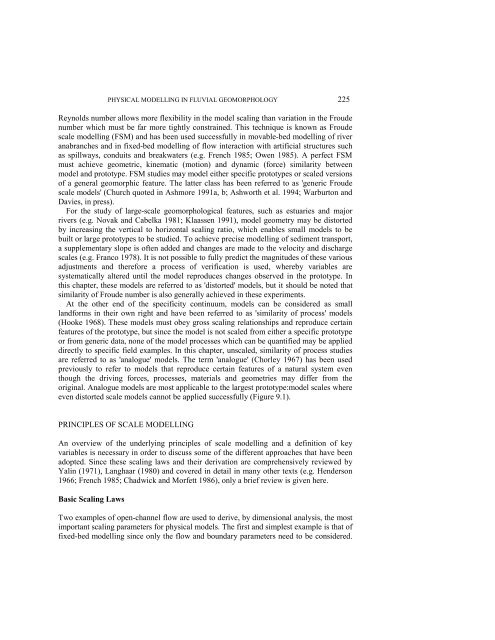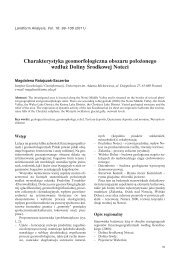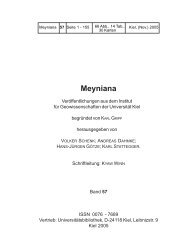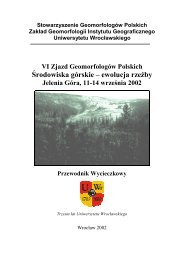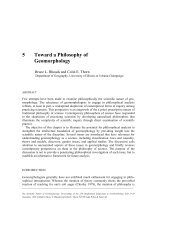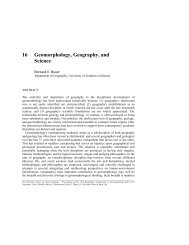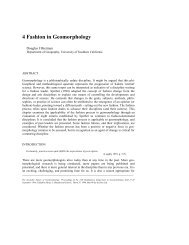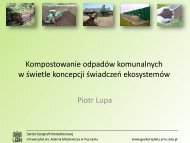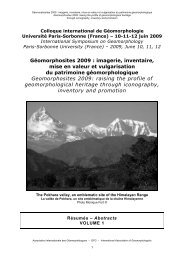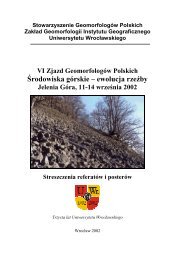Physical Modelling in Fluvial Geomorphology
Physical Modelling in Fluvial Geomorphology
Physical Modelling in Fluvial Geomorphology
You also want an ePaper? Increase the reach of your titles
YUMPU automatically turns print PDFs into web optimized ePapers that Google loves.
PHYSICAL MODELLING IN FLUVIAL GEOMORPHOLOGY 225<br />
Reynolds number allows more flexibility <strong>in</strong> the model scal<strong>in</strong>g than variation <strong>in</strong> the Froude<br />
number which must be far more tightly constra<strong>in</strong>ed. This technique is known as Froude<br />
scale modell<strong>in</strong>g (FSM) and has been used successfully <strong>in</strong> movable-bed modell<strong>in</strong>g of river<br />
anabranches and <strong>in</strong> fixed-bed modell<strong>in</strong>g of flow <strong>in</strong>teraction with artificial structures such<br />
as spillways, conduits and breakwaters (e.g. French 1985; Owen 1985). A perfect FSM<br />
must achieve geometric, k<strong>in</strong>ematic (motion) and dynamic (force) similarity between<br />
model and prototype. FSM studies may model either specific prototypes or scaled versions<br />
of a general geomorphic feature. The latter class has been referred to as 'generic Froude<br />
scale models' (Church quoted <strong>in</strong> Ashmore 1991a, b; Ashworth et al. 1994; Warburton and<br />
Davies, <strong>in</strong> press).<br />
For the study of large-scale geomorphological features, such as estuaries and major<br />
rivers (e.g. Novak and Cabelka 1981; Klaassen 1991), model geometry may be distorted<br />
by <strong>in</strong>creas<strong>in</strong>g the vertical to horizontal scal<strong>in</strong>g ratio, which enables small models to be<br />
built or large prototypes to be studied. To achieve precise modell<strong>in</strong>g of sediment transport,<br />
a supplementary slope is often added and changes are made to the velocity and discharge<br />
scales (e.g. Franco 1978). It is not possible to fully predict the magnitudes of these various<br />
adjustments and therefore a process of verification is used, whereby variables are<br />
systematically altered until the model reproduces changes observed <strong>in</strong> the prototype. In<br />
this chapter, these models are referred to as 'distorted' models, but it should be noted that<br />
similarity of Froude number is also generally achieved <strong>in</strong> these experiments.<br />
At the other end of the specificity cont<strong>in</strong>uum, models can be considered as small<br />
landforms <strong>in</strong> their own right and have been referred to as 'similarity of process' models<br />
(Hooke 1968). These models must obey gross scal<strong>in</strong>g relationships and reproduce certa<strong>in</strong><br />
features of the prototype, but s<strong>in</strong>ce the model is not scaled from either a specific prototype<br />
or from generic data, none of the model processes which can be quantified may be applied<br />
directly to specific field examples. In this chapter, unscaled, similarity of process studies<br />
are referred to as 'analogue' models. The term 'analogue' (Chorley 1967) has been used<br />
previously to refer to models that reproduce certa<strong>in</strong> features of a natural system even<br />
though the driv<strong>in</strong>g forces, processes, materials and geometries may differ from the<br />
orig<strong>in</strong>al. Analogue models are most applicable to the largest prototype:model scales where<br />
even distorted scale models cannot be applied successfully (Figure 9.1).<br />
PRINCIPLES OF SCALE MODELLING<br />
An overview of the underly<strong>in</strong>g pr<strong>in</strong>ciples of scale modell<strong>in</strong>g and a def<strong>in</strong>ition of key<br />
variables is necessary <strong>in</strong> order to discuss some of the different approaches that have been<br />
adopted. S<strong>in</strong>ce these scal<strong>in</strong>g laws and their derivation are comprehensively reviewed by<br />
Yal<strong>in</strong> (1971), Langhaar (1980) and covered <strong>in</strong> detail <strong>in</strong> many other texts (e.g. Henderson<br />
1966; French 1985; Chadwick and Morfett 1986), only a brief review is given here.<br />
Basic Scal<strong>in</strong>g Laws<br />
Two examples of open-channel flow are used to derive, by dimensional analysis, the most<br />
important scal<strong>in</strong>g parameters for physical models. The first and simplest example is that of<br />
fixed-bed modell<strong>in</strong>g s<strong>in</strong>ce only the flow and boundary parameters need to be considered.


